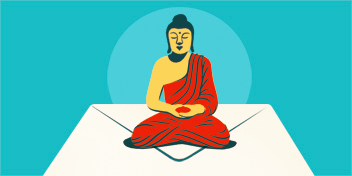Why, exactly, do runners run? “Most runners run not because they want to live longer, but because they want to live life to the fullest,” the acclaimed novelist Haruki Murakami, who is also an elite marathon runner, wrote in his 2009 memoir, What I Talk About When I Talk About Running. “Exerting yourself to the fullest within your individual limits: that’s the essence of running, and a metaphor for life.”
This year, going out for a jog has taken on new meaning. Requiring little equipment or overhead, running has provided immense support for many coping with the physical and mental toll of the COVID-19 pandemic. (Still, it’s important to be safe while doing so.) But as Murakami pointed out, for some, running can be much more than a way to stay healthy.
In her new book, Still Running: The Art of Meditation in Motion (Shambhala; August 11, 2020), Vanessa Zuisei Goddard offers an approach to running based on her background in Zen Buddhism. A lay teacher and former resident at Zen Mountain Monastery in Mount Tremper, New York, for nearly twenty years (14 of which were spent as an ordained monastic), Goddard shares her motivation for “still running” by opening the book with a passage from the Pali canon’s Udana Sutta. “For one who clings, motion exists; but for one who clings not, there is no motion . . . . Where neither arising nor passing away is, there is neither this world nor a world beyond, nor a state between. This, verily, is the end of suffering.” In a tradition best known for the literal stillness of its seated zazen meditation, Goddard, a runner for more than 35 years, elucidates the importance of spiritual stillness—the internal experience where craving ends—and explains how it can be cultivated through movement.
Tricycle spoke with Goddard about how running became an extension of her Buddhist practice and how her technique differs from other approaches to exercise and movement. (A glimpse of Goddard’s instructions excerpted from her book immediately follows the interview.)
What is “still running?” “Still running,” at its most basic, is a moving form of zazen meditation. I have always felt that, as incredibly powerful as seated zazen is, it’s not enough. The transition between stillness and movement—meditation and activity—doesn’t happen automatically; you need to cultivate it. Running is an excellent way of doing that because you’re using your whole being, both your body and your mind. And if you can bring the same kind of focus, presence, and awareness [that you bring to seated meditation] to running, there’s no reason you can’t do the same with other activities—working, cleaning, washing dishes, being with your child, and so forth.
The book emerged out of body-centered retreats you led at Zen Mountain Monastery (ZMM), where participants studied running as a form of spiritual practice. Can you tell me more about those? Those retreats naturally grew out of my training at the monastery. One form of Zen training is body practice, which John Daido Loori [ZMM’s founder and first abbot] always referred to as the study of self through the body.
T’ai chi, yoga, and qi gong are some traditional forms of body practice in a spiritual context, but because what I love to do is running, at a certain point I started to wonder, How can I practice running as a form of moving zazen? So I developed a personal practice.
Then I thought, Can I teach this to other people? I started teaching body practice during ango, our ninety-day training intensives, to experiment. The basic idea was: How to think about running as a spiritual practice and as a form of self-study.
As the retreats developed, were the participants experienced runners or were they beginners? I had a whole range: I’ve had people who have never done anything like this but were curious and people who have done quite a bit of running but wanted to delve into the spiritual or meditation component. The oldest participant was over 80 years old. She just walked.
We don’t do very long runs. There are many very good running and training programs out there, so I don’t pretend to be that at all. I’m trying to get people to make that connection between body and mind. All I call for is for people to get in their bodies—to actually be there as you are running, to be aware of what you are doing—because even a lot of athletes are not very embodied, if at all. I think one of the main reasons we get injured is because we don’t pay attention and we over-train.
What’s the key to making this practice sustainable? The way I put it is “running from the inside.” Still running puts emphasis on really feeling from the inside where you are. I can feel, OK, do I push today to feel energized? Or is it a slow day, and I should take it easy?
Because I have been able to do that, it has been a long time since I was injured. There are days that I think I am going to go run, but when I wake up every ounce of my being is saying “no,” and so I just don’t go. I don’t feel guilty about it anymore.
It can be difficult to balance that approach with motivation. I was supposed to run the New York City Marathon this year, before it was canceled, and I caught myself a number of times imagining the moment of crossing the finish line. While motivational, I think that fixation sometimes got in the way of my being present and listening to my experience. That’s true in zazen, too. We imagine what it will be like when we’re enlightened or when we have some degree of insight or quiet. Every once in a while we do experience something significant, and we try to hold on to it. I remember how much time I spent thinking I’m going to sit through the night or do something else extreme. Half the time I wouldn’t do it.
And then how would you feel when you didn’t do it? Bad. I should have pushed harder, or whatever. And if you are type A (a lot of runners are) and you have energy, you can spend a long time pushing. I have. I pushed my entire life, and I would just crash and burn. When I was practicing at the monastery, I would get sick a lot. I reached a point where I couldn’t [keep pushing] anymore, not in the same way. I saw how it was hurting me. I’m just beginning to learn to trust that I know what I need, and that my body knows. I’m much more willing and able than before to follow my own rhythm. I actually find that I am able to do a lot more because I don’t have to worry about crashing and burning.
What is the difference between still running and “flow” or being “in the zone?” [The psychologist] Mihaly Csikszentmihalyi, who wrote about “flow” in the ’90s, described it as a state of peak performance that is dependent on an optimal level of challenge. If the challenge is too high and you don’t have the ability to meet it, you can’t reach that experience. Likewise, you can’t reach it if your skill is too high and the challenge is too easy. There has to be optimal balance between the two.
People describe flow states as an experience of losing their sense of self, time slowing down or speeding up, and whatever activity they’re doing feeling effortless. I think all of us, when doing something that we feel very comfortable with and love to do, have touched that moment when we disappear.
Samadhi [Skt. concentration, or one-pointedness of mind] is similar to flow, but you’re not just cultivating concentration for its own sake. The point is to develop insight into the nature of the self, which is wisdom. You can certainly lose yourself on a run and it will feel good, but [still running asks] what does that say about the self that is disappearing to begin with? Where does it go? And what is it if it can come and go like that?
I don’t in any way pretend that going for a run is going to get you enlightened. I always have recommended and practiced running as a complement to seated zazen, and I would never replace my morning zazen with a run. What I am saying is that if you already have a running or movement routine, or if you want to begin one, you can use it to further your practice.
How can still running be applied to competitive running? I don’t think there’s anything wrong with competition. The question is: What do you do with it?
I haven’t been competing myself, but if I wanted to start I would have to keep working within myself to see my desire to win or improve as another aspect of my mind arising. Like with anything else within us, [the problem] is not the desire, it’s the attachment, the clinging.
I was very competitive throughout my time at the monastery. We used to play Frisbee, and everybody made fun of me for being so competitive. It’s kind of in me, so I didn’t try to pretend that it was otherwise. I would just see it and try to understand, What is that? Why do I need this? That is what actually helps and eventually gives us the ease to pick up [that competitive energy] when we need it and put it down when we don’t need it anymore. That’s freedom.
Is there anything else you would like to say about running? The world doesn’t need faster runners. We have plenty of them. We need people who are clear, people who are awake.
PRACTICE: STOP-START RUNNING
Practice focusing wholeheartedly on your breath.
A distracted, undisciplined mind is a mind lacking clarity and leaking energy. It is like a bucket with a hole or, to use a Buddhist simile, like a wild elephant. A concentrated mind, on the other hand, is stable and clear. It is a “firm post well sunk in the ground,” as Theravada Buddhist monk Soma Thera said. Having begun to develop our concentration in seated zazen, we will now take this discipline into running.
Before you begin, find a short route, something like a trail or a track. Choose familiar territory so you won’t have to expend energy figuring out where you’re going.
Run for ten or fifteen minutes at an easy pace to warm up. Then set a timer for ten minutes, thinking of this time as a period of running zazen. Just as with seated zazen, the focus of your moving meditation will be your breath. So as you run pay attention to the sensation of the breath as it moves in and out of your body. Listen carefully to its sound, matching your stride to the inhalation and exhalation. Let all your awareness be filled with breath.
Continue running until you notice a thought that distracts you from the breath. Following the instruction for zazen, see the thought, let it go, and in this case, stop running. By this I don’t mean you should slow down to a jog, but actually stop altogether. Take a moment to collect yourself, then start running again, placing all your attention back on the breath.
If you’re honest with yourself, you’ll most likely have to stop running every few steps, at least in the beginning. I realize this is annoying. But that is why this practice works. If you want to keep running, you really have to focus. So just remind yourself that you’re not trying to get anywhere. The point of this practice is to train your mind to concentrate.
Continue running with your attention on your breath. See a thought. Let it go. Stop. Resume running. Do this over and over until the ten minutes are up, then let go of your breath and keep running at an easy pace. Allow your awareness to be open, stable, clear, and relaxed. If you want to repeat the practice, alternate between ten minutes of stop-start running and ten minutes of more open, relaxed movement. Finish with easy running. Afterward, note your observations in your journal.
Stop-start running is the first step in the development of concentration while running. Return to this practice often, for one of the central aspects of learning—and discipline—is repetition. So learn how to use your breath to anchor your attention while running. Let it be the firm post that keeps you grounded in your being.
♦
From Still Running: The Art of Meditation in Motion, by Vanessa Zuisei Goddard © 2020. Republished with permission of Shambhala Publications.




No comments:
Post a Comment